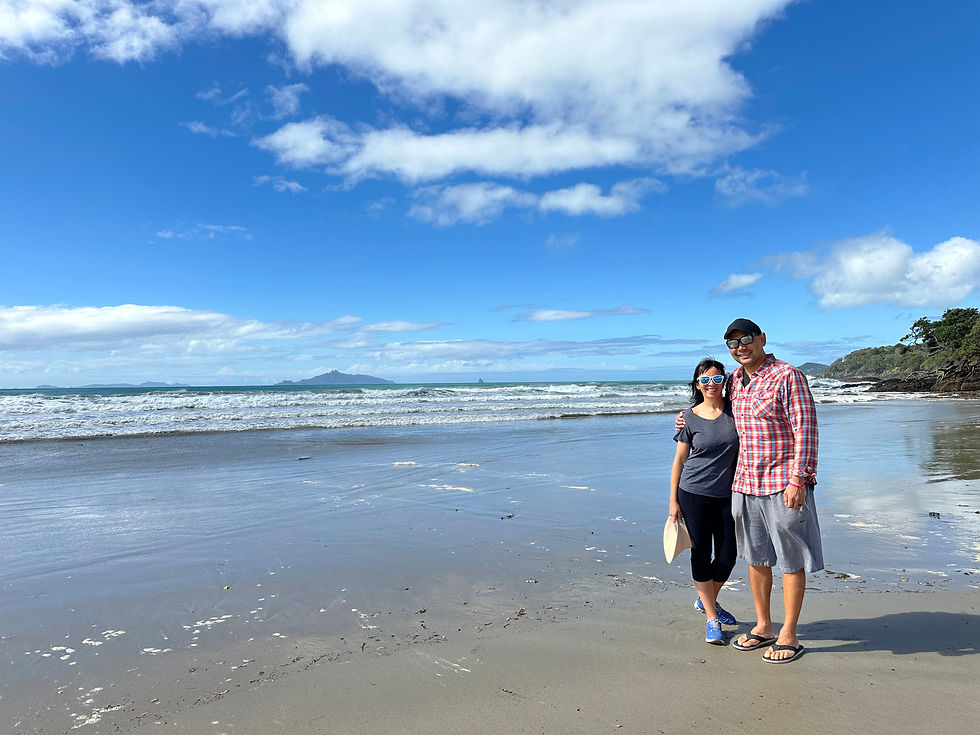New Zealand arrival & Northland
- Trae Tashiro
- Apr 14, 2024
- 3 min read
Updated: May 10, 2024
We were so excited to arrive in New Zealand after our overnight flight. The view from the plane showed off the beautiful green island and huge open spaces.

We started driving North to Paihia in Northland. We passed green rolling hills, cows, sheep, and goats. There are 6 times the number of sheep than people here!

This will be the longest roadtrip our family has ever taken - 20 days, moving nearly every day. Trae has driven on the left side of the road like a champ although he clearly requires a lot of concentration. Grayson thinks it helped that he hasn’t been driving at all for the past 9 months - “starting fresh”. I’m not so sure. Poppy snapped back into her advanced car snoozing skills like they were second nature.



Every stop has held such beauty. We stopped to use the bathroom at a beachside park. A wide open beach was nearly empty except for a few surfers.


We stopped at Whangārei Falls - a massive waterfall embedded in a regular neighborhood of a small town. We watched neighbors walk their dogs - quite a step up from our beloved mushroom park back home.

Everyone seems pretty relaxed here. We see people with bare feet everywhere- on hikes, eating in restaurants, even grocery shopping. Mullets are common and unironic.
We also see messages about the values important here.
Belonging to and caring for the land, cleaning up after yourself, & minimizing waste.

Sharing ideas and extra belongings.


Being inclusive.

just outside Paihia, we visited the Waitangi Treaty Grounds to learn more about NZ’s history. On this site, 540 Māori chiefs and representatives from Britain signed a treaty. Our guide, James, was 7th generation Māori, a descendant of 2 chiefs. He told us about his ancestors sailing from Polynesia; he showed us photos of the war boats and told us about master carvers who proved their skill by carving an entire canoe by themselves.

James told us about the nearby port becoming the busiest trading site in the southern hemisphere and the related drinking and violence that came with sailors and traders from around the world. He shared that Britain sent representatives to build relationships and offer protection and laws - creating a treaty. He described how the English version of the treaty and the version translated to Māori (the version the chiefs signed) didn’t match. The most important part of the tour was when one fellow tourist with a British accent asked, “was the mistranslation on purpose or an accident?” James paused and clarified “purpose is a complicated word. Read the different versions of Article 1. You will see.” The translation gave the impression the Māori would have power over their country and protection from Britain. In reality, the English version elevated British sovereignty over the chiefs’ authority and also restricted sale of land only to the British crown. Many years of colonization, land confiscation, war, and protest would take place before Queen Elizabeth would eventually apologize and a tribunal established to receive grievances and pay out claims.


Our final stop was at the Māori meeting house carved by 12 master carvers over 6 years. Each panel was specially carved to symbolize different tribes from across the north island.


The building was designed to represent entering the belly or womb of Māori ancestors with ribs along the side of the ceiling. — Kim w help from Grayson




How dare you disgrace Mushroom Park like that! (But I totally agree with you lol)
-Alexa
Beautiful pictures of nature - such wonderful experiences of a lifetime! CeCe🥰
Holy cow! 20 days on the road in New Zealand? You people know how to live the best life… Love the stories about the Maori… I don’t think colonization has ever been good for the local population.